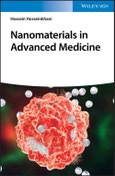Nanomedicine offers a range of multi-interdisciplinary approaches and brings together the field of chemistry, pharmaceutical science, biology, and clinical medicines by focusing on design and preparation of biodegradable or non-biodegradable biomaterials for their biological, medical, and pharmaceutical applications. Nanomaterials in Advanced Medicine reviews the concepts and applications of the combination of the technology of biology and engineering that are emerging as an integral aspect of today?s advanced medicine. Nanomedicine provides the technology for imaging, cancer treatment, medical tools, bone treatment, drug delivery, diagnostic tests, drug development, angiogenesis and aims to exploit the improved and often novel physical, chemical, and biological properties of materials at the nanometer scale.
Designed to provide a broad survey of the field, Nanomaterials in Advanced Medicine is divided into three main sections: Nanophysics, Nanochemistry, and Nanomedicine. Each chapter describes in detail the most current and valuable methods available and contains numerous references to the primary literature. This important book:
-Offers a field guide for biologists and physicians who want to explore the fascinating world of nanotechnology
-Contains a comprehensive review of the topic from a noted expert in the field
-Includes an introduction to nanotechnology and explores the synthesis, structure and properties of various types of nanobiomaterials
-Bridges the gap between various aspects of nanomaterials? development technology and their applications
Written for pharmaceutical chemists, biotechnologists, life scientists, materials scientists, polymer chemists, and biochemists, Nanomaterials in Advanced Medicine provides a must-have guide to the fundamental concepts and current applications of nanomaterials in the medical field.
Table of Contents
Preface ix
1 Introduction to Nanotechnology 1
1.1 Introduction 1
1.2 Importance of Size in Nanotechnology 2
1.3 Approaches in Nanotechnology 2
1.3.1 Top-Down Approach 2
1.3.2 Bottom-Up Approach 3
1.4 Impact of Nanotechnology 4
1.4.1 Sensors for the Automotive Industry 4
1.4.2 Health and Medicine 5
1.4.3 Energy and Environment 5
1.4.4 National Security 5
1.5 Nanotechnology Applications 6
1.5.1 Information Technology 6
1.5.2 Energy 6
1.5.3 Medicine 6
1.5.4 Consumer Goods 6
1.6 Summary and Challenges 6
References 8
2 Biomaterials in Medicine 11
2.1 Introduction 11
2.2 Biodegradable Polymers 20
2.3 Natural Biomaterials 25
2.3.1 Gelatin 26
2.3.2 Pectin 27
2.3.3 Chitosan 28
2.3.4 Cyclodextrins (CDs) 29
2.3.5 Dextran, Dextran-Spermine (D-SPM) 30
2.3.6 Miscellaneous Polysaccharide Polymers 32
2.3.6.1 Pullulan 32
2.3.6.2 Schizophyllan 33
2.3.6.3 Alginic Acid 33
2.3.6.4 Hydroxypropyl Cellulose 33
2.3.6.5 Glycosaminoglycans 33
2.3.7 Modified Polysaccharides as Gene Delivering Agents 35
2.3.8 Cationic Lipid 38
2.4 Biodegradable Nanoparticles 39
References 40
3 Classification of Nanomaterials 47
3.1 Introduction 47
3.2 Classification of Nanomaterials 48
3.2.1 Nanoparticles 48
3.2.2 Nanofibers, Nanowires, and Nanorods 49
3.2.3 Self-assembly of Proteins and Peptides 52
3.3 Nanocarriers 54
3.3.1 Nanocarriers in Gene Therapy Technology 54
3.3.2 Nanocarriers in siRNA Technology 55
3.3.3 Colloidal Carrier System 57
3.3.4 Nanoparticulate System 59
3.4 Nanoscaffolding Materials 59
References 60
4 Nanomaterials in Gene Therapy Technology 63
4.1 Introduction 63
4.2 Approaches to Gene Therapy 64
4.2.1 Viral Vectors for Gene Delivery 64
4.2.2 Nonviral Vectors for Gene Delivery 65
4.2.2.1 Cationic Polymers 65
4.2.2.2 Cationic Lipid 72
4.2.2.3 Conventional Phosphate Method 72
4.2.2.4 Cell-Receptor-Mediated Uptake 72
4.3 Physical Methods for Gene Delivery 78
4.4 Combination of Physical and Nonviral Methods to Enhance DNA Nanoparticle Uptake by the Cells 80
4.5 Summary 91
References 92
5 Nanomaterials in Gene-Silencing Technology 109
5.1 Introduction 109
5.2 Gene Silencing 110
5.2.1 siRNAs 110
5.2.2 shRNAs 110
5.2.3 miRNAs 111
5.3 Approaches to siRNA Delivery Systems 111
5.4 siRNA Technology in Cancer Therapy 113
5.5 Future Prospects 114
References 114
6 Imaging Technology 117
6.1 Introduction 117
6.2 Polymeric Nanoparticles in MRI Technology and Disease Therapy 119
6.3 Surface-Coating Polymer in Nanoparticles 121
6.4 Drug Delivery with Polymeric Nanoparticles 122
6.5 Stimuli-Sensitive Drug Delivery 123
6.6 Multifunction of Targeted Drug Delivery 124
6.7 Gene Transfer via Polymeric Nanoparticles in Drug Delivery 124
6.8 Magnetic Hyperthermia 125
6.9 Future Prospects 126
References 126
7 Nanotechnology in Natural Hydrogel 133
7.1 Introduction 133
7.2 Mechanical Properties of Hydrogels and Interpenetrating Networks 134
7.3 Engineering Hydrogels with Controlled Mechanical, Chemical, and Biological Properties 138
7.4 Developing Methods of Fabricating Composite Biodegradable Hydrogels Using IPNs 139
7.5 Engineering Approaches to Deliver Growth Factors from Hydrogels 142
7.6 Drug Delivery Systems Using Polymeric Hydrogel 143
7.7 RNA-Responsive Hydrogels 146
7.8 DNA-Responsive Hydrogels 146
7.9 Aptamer-Responsive Hydrogels 147
References 148
8 Nanotechnology in Tissue Engineering 151
8.1 Introduction 151
8.2 3D In vitro Systems 153
8.2.1 Porous Scaffolds 153
8.2.2 Hydrogels 156
8.2.3 Self-assembly of Proteins 158
8.3 Cellular Microenvironment 160
8.3.1 Extracellular Matrix 160
8.3.2 Cellular Microenvironment (Niche) 160
8.3.3 Nerve Tissue 161
8.4 3D Technology on Frontier of Neuroscience 162
8.4.1 Tissue Engineering 162
8.4.2 Development of 3D In vitro Cell Culture Technology 164
8.4.3 Nerve Regeneration in 3D Models 164
8.4.4 Nanotechnology in Neuroscience 166
8.5 Regenerative Medicine Therapy 167
8.5.1 Specific Mediated Nanomaterials 167
8.5.1.1 Three-Dimensional Peptide Matrices 168
8.5.1.2 In vitro Biological Approaches of Self-Assembled Systems 169
8.5.1.3 Antimicrobial Activities 169
8.5.1.4 Cell Culture Scaffold for Tissue Engineering 170
8.5.1.5 Drug and Gene Delivery 171
8.5.2 Biomineralization Materials 174
8.5.3 Self-Assembled Systems in Regenerative Medicine Therapy 174
8.5.4 Enhancement of Angiogenesis in Self-Assembled Systems 175
8.5.5 Enhancement of Bone Regeneration in Self-Assembled Systems 178
8.5.6 Other Forms of Self-Assembled Systems in Regenerative Medicine 178
8.6 Future Prospects 179
References 180
9 Safety Issue of Nanomaterials 187
9.1 Introduction 187
9.2 Biocompatibility and Toxicity of Nanomaterials 188
9.2.1 In vitro Biological Approaches of Nanomaterials 188
9.2.2 Cell Cytotoxicity Assay 190
9.2.3 Chemical Reference Standard 190
9.3 Safety Issue of Nanomaterials 191
9.3.1 Quality Assurance Statement 191
9.3.2 Environmental, Health, and Safety Issues of Nanomaterials 192
9.3.3 Biohazard of Nanomaterials 193
9.4 Limitations of Nanomaterials Technology in Nature and Medicine 194
9.5 Future Prospects 195
References 196
Index 203








